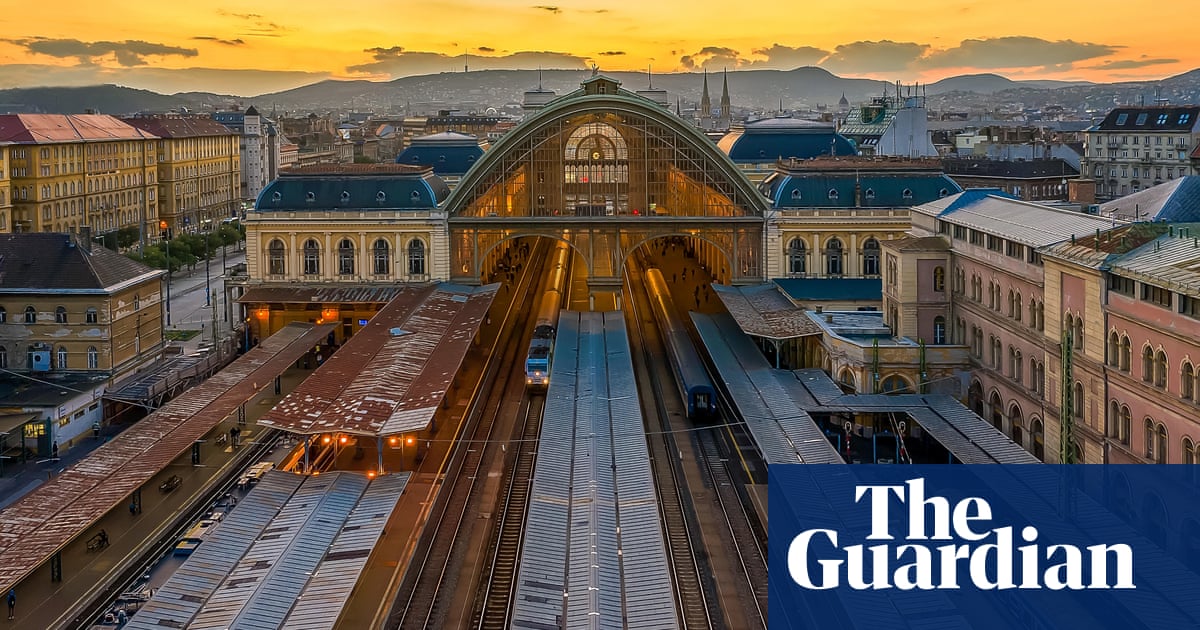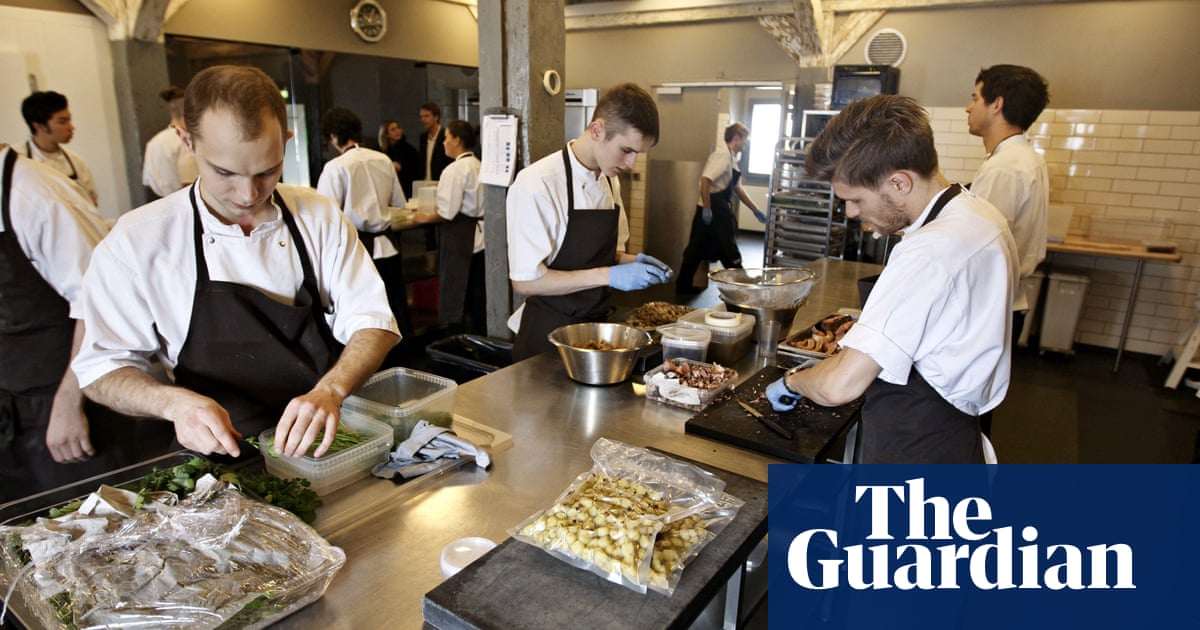
I’m somewhere south of Paris when it occurs to me that, had I flown, I would be there by now. At the far end of the carriage, I can see the train speedometer touch 300kmph (186mph) then settle at 296, a pace that, before the invention of the jet engine, would have left most civil aeroplanes for dead. The most advanced Belfast-built flying boats, beloved of Imperial Airways before the second world war, cruised to South Africa at lesser speeds.
The guard comes on the intercom to thank us for “travelling ecologically”. Outside the window a ruined chateau sweeps past, then a herd of deer grazing peacefully. To the east I see the pale shimmer of snow-capped peaks, with Mont Blanc rising above them.
I am heading for Morocco overland, which involves a three-day rail and ferry epic, rather than a four-hour flight. First came York to London, where the Eurostar to Paris was followed by a metro to Gare de Lyon for the express to Barcelona. Ahead is a night in Barcelona, trains to Madrid and then Algeciras on the south coast, another night in a hotel, then an early bus transfer to Tarifa for the ferry to Tangier.
The reason I am doing this is because it is better for the environment, but that impressive speed triggers some anxiety. How can this be so much better? Perhaps there is also a lingering doubt, a relic of the HS2 furore. Are railways really much better? As we cut swiftly through some lavender fields, I search for answers.
In CO2 terms, at least, the truth is quickly apparent. Emissions from rail travel are about 13 times lower per passenger than for air travel. What, however, about all the land use, the stations … everything?
I find a European Environment Agency report from 2020 that goes into the minutiae of comparative environmental costs, taking into account factors such as railway shunting requirements, particulate pollution and noise as well as CO2. Their conclusion is that air travel is not always the worst choice – driving alone in a diesel car can be more damaging - but rail travel is overwhelmingly less harmful.
I try to account for everything: the two nights in hotels, the extra food, the extra time spent breathing (an average human produces about 1kg of CO2 a day), but of course I would be eating and breathing anyway. I allow that the plane itself might be fuel-efficient – there’s a fascinating article in Flying magazine about that – and planes do differ. But flying is not good. If you can do without a flight, you should.
Regardless of the maths, however, what I am enjoying is something flying can never provide: the subtle changes in the unfurling of landscape, the slow goodbye to wheat and potato fields, then the arrival of citrus and palm.
Turning right towards the Spanish border we pull into Béziers, and I wish I had planned to jump off and explore this fascinating town. In 1209, a crowd of 20,000 people, a mix of local Catholics and Cathars, regarded as religious heretics by the pope, were slaughtered in Béziers by crusaders from the north. The papal legate, Arnaud Amalric, observing the massacre, is said to have shrugged off objections with the infamous words: “Kill them all and let God sort out his own.” It’s a reminder that change in the physical landscape is not all that is altering. The history and culture that formed the human landscape here is different.
I return to my modern-day CO2 musings. On the evidence, it’s pretty clear that you should not fly when you can avoid it (even the time spent idling and taxiing can emit more than 500kg of CO2 – sufficient to take a rail passenger from Aberdeen to Penzance almost a dozen times). But, of course, the extra cost of travelling overland is hard to swallow. A return flight to Marrakech from London can be had for as little as £54, whereas my rail fares alone, at best, are going to set me back £350. How on earth do these airlines stay in business given fuel prices and the amount they consume?
Perhaps the effects of not flying on your wellbeing might help to justify the price. The plane sells the dream of getting there faster, but do you really want to deal with the queues, the chaos, the delays, the steady thump of the child in the row behind kicking your seat, and the man with the permanent frown who wants to watch the Predator films without headphones. Avoiding all this is surely worth the extra cost of the train, I think as we pull into Barcelona.
The city looks stunning in the twilight, the towers of the Sagrada Família rising on the horizon. I take tapas and beer in a little bar near the station, chat to some locals, then stroll back to my hotel. One side-effect of travelling this way is that it’s much more flexible: after Morocco I plan to detour via Galicia on the way back and spend a week walking. If I was flying, I doubt I’d have done that.
Next morning I eat churros with a café con leche and watch the sun light up the Sagrada Família. I’ll admit to a pang of doubt: should I have taken two days out? I could have visited Gaudí’s masterpiece, plus his other works, toured the Gothic Quarter, and grabbed some tapas in La Boqueria market. Maybe I need to lose that airline-induced desire for the speedier arrival? By midday I am halfway to Madrid, zipping through the peach groves of Catalonia. I am starting to wish these trains went a little slower.
In Madrid, I have two hours to kill and walk up to the Retiro Park. The bookshops that I recall from when I lived here in 1986 still line Calle del Doctor Velasco. It’s like catching up with an old friend. Atocha station has been rebuilt and needs exploring. The city also has some of my favourite art galleries: the Prado, of course, but also the Thyssen-Bornemisza and Reina Sofía. Best of all is the church of Real Parroquia de San Antonio de la Florida where Goya painted the interior and is now buried.
The next leg is across deserted lands of Castilla La Mancha. For centuries this was the buffer zone between Christianity and Islam, a vast area dotted with gnarled olive trees and skinny cattle. We stop at Puertollano, which looks interesting. I discover it’s the birthplace of María Dueñas, author of The Seamstress, a 2009 novel set in Spain and Morocco during the second world war. Without that brief halt, I would never have come across her.
By Córdoba, the architecture has a Moorish slant. In Antequera, instead of carrying on on the main line to Málaga, we switch to the smaller Mr Henderson’s Railway. Built in the 1890s by British engineer John Morrison (Mr Henderson financed it), this is a spectacularly beautiful meander through the mountains of Andalucía, weaving its way via Ronda down to Algeciras.
The air is warm now. I’m sliding gently into yet another climate zone, unlike the brutal changes of air travel. And there’s no chance of announcements like “Passengers are informed that French air traffic controllers are now on strike. Please remain seated.” Or the man with the permanent frown turning up the volume on Predator 2.
In Algeciras I get the first whiff of Africa. Signs in the streets are in Spanish and Arabic. The lights of Gibraltar look very close, as do those of Morocco across the strait. I sleep at Hotel Reina Cristina (doubles from €75) built by Mr Henderson’s railway company. In the morning I jump on the FRS ferry company’s complimentary bus to Tarifa. The beauty of this corner of Spain staggers me: the mountains are green and every tall chimney seems to host a pair of storks.
Tarifa is another worthy stopover. This is the southernmost point of continental Europe and was fought over for centuries and occupied by many cultures – even the British were resident, briefly, during the 1807-14 Peninsular war. Now its fame is as a windsport destination and a birdwatchers’ paradise. During migrations birds funnel through from Africa. Raptors such as vultures and eagles use the thermals to gain height while others like swifts and swallows gather for the crossing. The sheer mixture of birds to be spotted in one day can be astonishing: flamingoes and bee-eaters with puffins and owls. There is a birdwatching lookout, the Mirador del Estrecho, up on the hill. I should have stopped a night here, but it’s time for the hour-long ferry crossing.
At its narrowest, the strait of Gibraltar is just eight miles wide, just a little more in distance than the altitude of the jets flying over. In Tangier I walk through the cool catacombs of the casbah. The usual feelings I associate with arriving somewhere like this – vulnerability, awkwardness, fatigue – are absent. I am simply happy. Even the tiniest shops look worthy of a morning’s exploration, and here, tucked down a narrow alleyway, is the American Legation building, with its wonderful courtyard garden and a room dedicated to the writer Paul Bowles. Beyond lie much-anticipated delights, such as the markets of Marrakech and Fez, hiking and rock climbing in the Atlas Mountains, and surfing on the Atlantic coast. But perhaps I will stay in Tangier. What’s the rush? On this overland epic, it’s the journey that has hijacked me.












